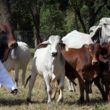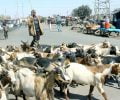The most expensive pedigree bull has fetched a lucrative K82,000 at the 2017 Stanbic Livestock Auction which was recently held in the Lusaka Showgrounds.
On offer were high quality breeds such as Bonsmara, Angoni, Boran, Brahman, Santa Gertrudis and Tuli, as well some Boer goats and sheep.
The most expensive bull sold at this year’s auction was the Bonsmara breed; a South African breed, which was auctioned for K82,000.
The Santa Gertrudis breed was second at K62,000 while the Brahman breed occupied third and fourth position at K48,000 and K30,000.
But Chairman of the Herdbook Society of Zambia Quentin Cantlay said this year’s auction went very well despite recording lower average prices than those recorded last year.
“The average prices were lower this year compared to last year. This year, prices were 30% lower, which doesn’t give a very good outlook,” said Cantlay.
“Farmers this year are grappling with so many things including higher costs of electricity, levies, feed and other inputs.”
Cantlay said, however, that despite the depressed prices, there was keen interest among buyers with 23 out of 28 bulls getting new owners at the auction while 12 out of 17 small ruminants (goats and sheep) were sold.
Stanbic Bank chairman Dr Austin Mwape said the bank was pleased to have been associated with the Livestock Auction for the past seven years.
“We have sponsored this event because of the strong belief we have in the potential of the agriculture sector in general – and the livestock sector in particular – to turn around the fortunes of this country,” Dr Mwape said.
“In the pursuit of food security, accelerated poverty reduction and a more diversified economy, the country has targeted agriculture as a priority growth sector. Growth in the agriculture sector, which employs about 70% of the population, is the key to poverty reduction in Zambia.”
Dr Mwape said the livestock sector, which contributed about 42% of agriculture GDP in Zambia, made an important contribution to poverty reduction, household food security and nutrition, economic growth and exports.
“To us, agriculture remains one of the bank’s top priority sectors. Our purpose as a bank is to drive Zambia’s growth and we believe that we area achieving this by our investment in the agriculture sector, apart from other economic sectors,” said Dr Mwape.
“We remain committed to supporting the agriculture sector despite the challenges the sector faces. We have financed infrastructure projects in agriculture amounting to ZMW2 billion, which makes Stanbic the highest lender in the agriculture sector.”
Meanwhile, Fisheries and Livestock minister Michael Katambo, who graced the occasion, paid tribute to breeders of pedigree stock in Zambia and issued a stern warning to people who import and sell substandard animals.
“There are always dishonest traders who bring in animals that are below standard. Let me take this opportunity to warn such people that if they are caught in this criminal act, they will be arrested and prosecuted,” he warned.
Katambo said the government had instituted several measures aimed at improving the livestock sector in Zambia, including constructing artificial insemination centres across the country and revamping the national artificial insemination centre in Mazabuka.
“The fisheries and livestock sector is a key economic sector that has been earmarked as the engine of Zambia’s economic growth, diversification and job creation. To realise the potential, government has put in place measures aimed at making the sector more productive, market and export oriented,” he said.
He said he was in support of the Herdbook Society on issues concerning the importation and sale of quality breeding stock from outside Zambia.
He however called on farmers to preserve local breeds which played a vital role in the rural economies.
“Indigenous breeds play a vital role in the lives of poor rural populations. It’s important that these breeds are recognized for their special merits and promoted by policies and practices. It’s important to conserve indigenous livestock strains and develop appropriate livestock production technologies through applied livestock research and conservation strategies and value addition to benefit livestock farmers,” said Katambo.












